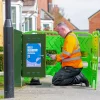Cityfibre Secure Judicial Review of “Misleading” Fibre Broadband Ads
The UK High Court has today granted Cityfibre permission to proceed with its Judicial Review of the Advertising Standards Authority’s decision regarding the use of “fibre” terminology in broadband ISP advertising, which the operator has often accused of being “misleading” for consumers.
The debate over what should and should not be considered “fibre broadband” in UK advertising has been going on since 2008, after the ASA allowed so called slower “hybrid fibre” or “part fibre” services (e.g. FTTC, G.fast or HFC DOCSIS networks that combine fibre with slower metallic copper or aluminium cables) to use the same wording as pure “full fibre” (FTTH/P) ISPs that take the optical fibre all the way to your home or office.
Pure fibre optic ISPs can deliver significantly faster speeds (i.e. they’re technically able to handle multi-Gigabit or even Terabit speeds) and are generally more reliable, while hybrid-fibre services tend to be slower and less reliable. Experiences do vary, depending upon the network setup and length of metallic cable, but generally there’s a big difference (Will the real fibre optic service please stand up?).
Advertisement
In the past, few paid attention to this debate, which is partly because FTTP/H networks were tiny, but today operators are in a race to deploy such services out to millions of UK premises (see our summary). As such it has become increasingly important for ISPs to be able to highlight the advantages of a pure fibre line vs a hybrid fibre one. This is naturally made more difficult when your part fibre rivals are allowed to use the same terminology.
Last year the ASA finally, under a lot of pressure, agreed to review the situation but in the end they only recommended minor tweaks (here). In its conclusion the ASA claimed that “fibre” was not one of the priorities identified by consumers when choosing a package; that consumers did not notice “fibre” claims in ads and that they saw it as a shorthand buzzword to describe modern fast broadband.
Overall consumers told the ASA that they did not believe they would change their previous decisions, even after the differences between those services and broadband services that use fibre optic cables all the way to the home were explained to them.
Naturally Cityfibre, which has built multiple Fibre-to-the-Premises (FTTP) networks across the UK, disagreed and argued the “research and logic that lead to the [ASA’s] decision was fundamentally flawed” and that it encourages slower hybrid fibre ISPs to “continue to mislead consumers.” In response the operator began seeking a Judicial Review against such advertising and the High Court has today allowed them to proceed.
Advertisement
Greg Mesch, Founder and CEO of CityFibre, said:
“The High Court is seeing sense where the ASA failed to: this is the right decision for consumers and our economy. CityFibre challenged the ASA’s decision because consumers must not be misled into thinking they can get full-fibre benefits on a copper broadband network – they can’t: copper is dead.
It is now time to sort out these advertising rules once and for all, and for the Government and industry to get behind the nationwide broadband targets set by the Chancellor. Companies are investing billions because of the transformative connectivity full fibre brings; the Court has a one-off chance to step in and make a difference for consumers before the mis-selling of broadband becomes the next PPI-style scandal.”
At the hearing, Cityfibre’s representatives argued that there were “serious limitations in the methodology the ASA used in research it says justifies its decision, and that the findings they presented actually supported the view that the use of ‘fibre’ was misleading for consumers.”
Summary of Cityfibre’s Claims:
* The methodology did not qualify the ASA to make generalisations or to extrapolate its findings to the wider population.
* The demographic selection was not representative and did not take proper account of socio-economic group A.
* The ASA’s findings in fact supportive of the view that the indiscriminate and current widespread use of the word fibre is misleading –
—- “When viewing full-fibre ads, only a minority of participants immediately understood that full-fibre providers offered something different.”
—- And even after the difference between full and part fibre was explained, two-thirds of respondents were still unable to differentiate between full and part-fibre ads.
The ASA will now have 35 days to prepare their counter case, which should prove to be an incredibly interesting one due to the inherent clash of technology and marketing. Nevertheless, win or lose, it will remain very difficult to unpick something that has long since become established in the consumer subconscious, where the meaning of “fibre” has been diluted over years of use (or misuse) by slower hybrid (part) fibre services.
Furthermore if Cityfibre wins then this could conceivably place a question mark over Gigabit capable Fibre-to-the-Building (FTTB) providers, such as Hyperoptic, where only a little bit of the overall connection is still technically copper (i.e. cabling inside the building itself). Even Openreach has some slower FTTB solutions that use VDSL2 technology (aka FTT-Basement). France has already taken a very tough line on this (here).
As a side note, ISPreview.co.uk ran a snap poll of 200+ respondents when the ASA announced their decision last year and 83% agreed that only FTTH/P ISPs should be able to use “fibre broadband” in advertising. Cityfibre’s action has also received wide support from other full fibre ISPs, such as Gigaclear and Vodafone etc.
Advertisement
Mark is a professional technology writer, IT consultant and computer engineer from Dorset (England), he also founded ISPreview in 1999 and enjoys analysing the latest telecoms and broadband developments. Find me on X (Twitter), Mastodon, Facebook, BlueSky, Threads.net and Linkedin.
« Battle of the Fibre Optic Patents as Emtelle Take Hexatronic to Court UPDATE
Broadband ISP Zen Internet Launches New UK Website »


















































Comments are closed